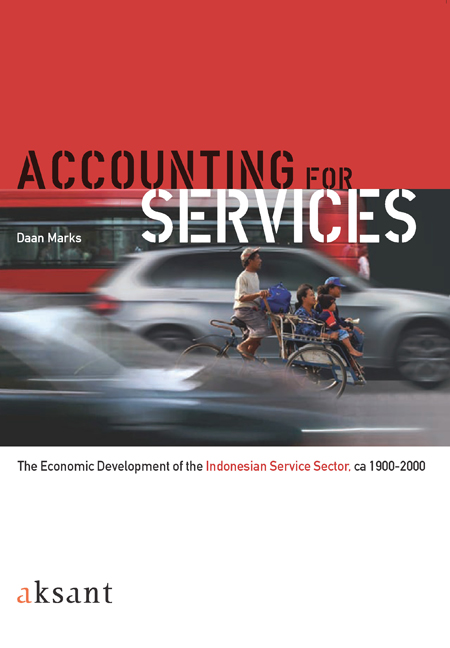Book contents
- Frontmatter
- Contents
- List of Tabels
- Acknowledgement
- 1 Introduction
- 2 National Accounting for Services in Indonesia
- 3 The Development of the Indonesian Service Sector: A Quantitative Analysis
- 4 Roads to Riches? Transportation and Economic Development in Indonesia
- 5 Involution and Growth: the Ambiguous Role of the Trade Sector in the Economic Development of Indonesia
- 6 Unity or Diversity?: Market Integration through Trade and Transport
- 7 Conclusions
- Appendices
- References
Appendix 5 - National Accounting for Financial Services
Published online by Cambridge University Press: 19 January 2021
- Frontmatter
- Contents
- List of Tabels
- Acknowledgement
- 1 Introduction
- 2 National Accounting for Services in Indonesia
- 3 The Development of the Indonesian Service Sector: A Quantitative Analysis
- 4 Roads to Riches? Transportation and Economic Development in Indonesia
- 5 Involution and Growth: the Ambiguous Role of the Trade Sector in the Economic Development of Indonesia
- 6 Unity or Diversity?: Market Integration through Trade and Transport
- 7 Conclusions
- Appendices
- References
Summary
According to SNA 93, output of financial intermediation companies in banking, insurance services and pension fund services cannot be directly measured since such companies do not normally charge their customers for their services except for some minor incidental services. Banks earn their main source of income by the difference between the interest earned by providing loans and the interest paid on deposits. Pension funds and insurance companies accept contributions and invest them in order to pay their customers. Their output has to be measured indirectly. This has also been done in Indonesia.
Firstly value added was estimated for the colonial period. The procedure adopted is the following. For the ‘big four’, namely the Java Bank, NHM, NIEM and NIHB, the financial report of the Java Bank is taken as starting point. Their annual reports are actually available, but they have a number of short-comings: 1) they are often less detailed, 2) it is often hard to sub-divide income in the Netherlands from income in the Netherlands-Indies, and/or 3) it is hard to sub-divide income from banking and income from trade activities.
Therefore I chose to use annual reports by the Java Bank, which give a very detailed statement of income and expenditures. Value added of the Java Bank is then divided by the share of credit extension of the Java Bank in total credit extension of the ‘big four’.
For the other financial institutions, i.e. the Saving Banks, the Government Pawnshop service and the Government Credit banks, detailed financial accounts are available, which make it possible to estimate value added in a direct way. The data and results are summarised in appendix table A5.1.
- Type
- Chapter
- Information
- Accounting for ServicesThe Economic Development of the Indonesian Service Sector, ca 1900–2000, pp. 299 - 306Publisher: Amsterdam University PressPrint publication year: 2009



